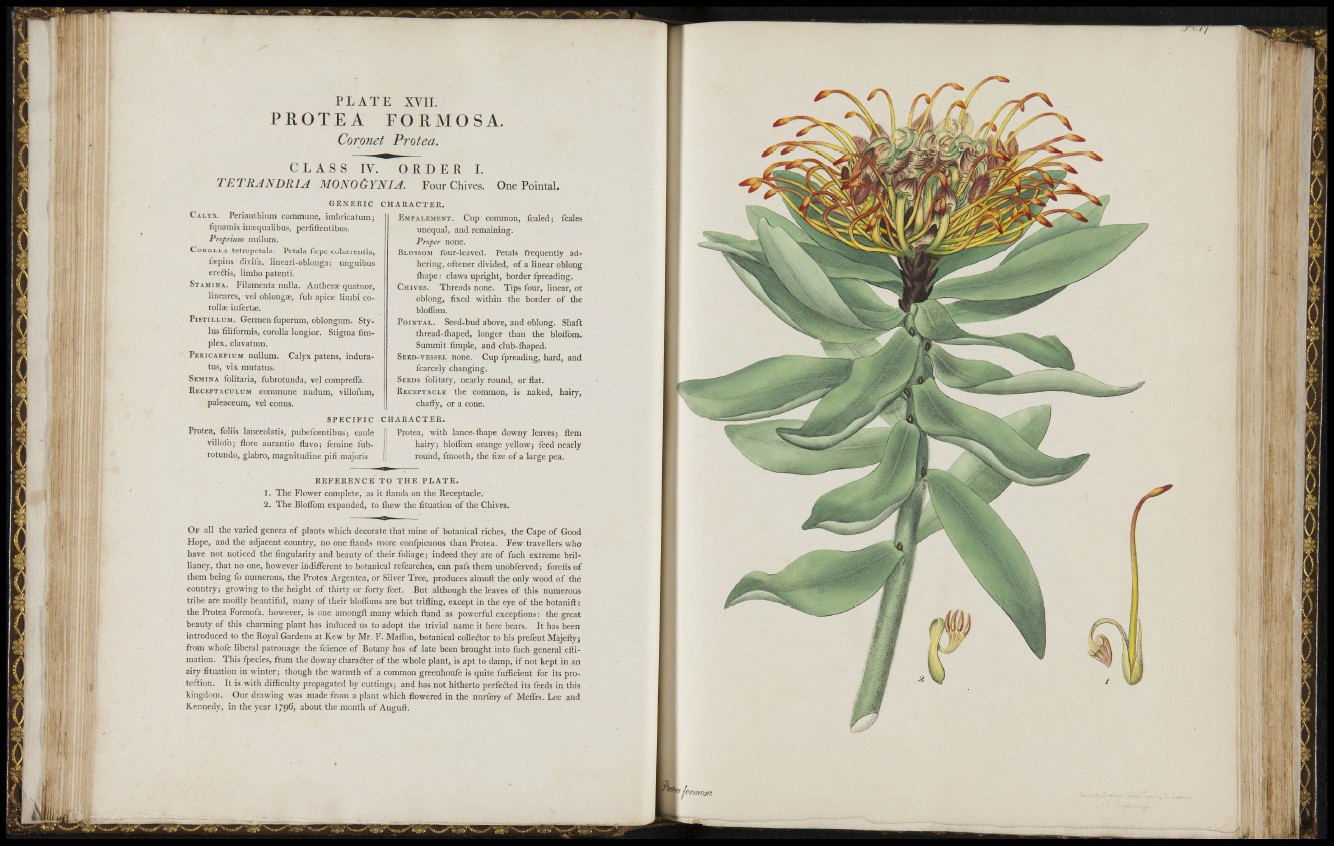
i 11'
• ' I )
' J: ^
P L A T E XVII.
P R O T E A FORMOSA.
CoroJiet Protea.
C L A S S IV. ORDER 1.
T ET RA NDR IA MONOÖYNIA. Four Chives. One Pointal.
G E N E R I C
C A L Y X . Perlanthinm commune, imbricatum;
fquarais in.'cqiialibus, perfiflentibiis.
Proprium nullum.
C O R O L L A tetnipetala. Pelala fope coha?rentia,
iaepios divifa. lineari-oblonga : unguibus
eredis, limbo patenti.
S T A M I N A . Filamenta nulla. Anther.TE quatiior,
lineares, vel oblongae, fub apice limbi corolla:
inlertie.
P I S T I L L U M . Germen fuperum, oblongum. Stylus
filiformis, corolla longior. Stigma fimplex,
clavatum.
P E K I C A R P I U M nullum. Calyx patens, induratus,
vix mutatus.
S E M I N A folitaria, lubrotunda, vel comprefla.
E E C E P T A C U L U M commune nudum, villofum,
paleaceum, vel conus.
S P E C I F I C
Protea, foliis lanceolatis, pubelcentibus; caule
villolb; flore aurantio flavo; famine lubrotundo,
glabro, magnitudine pifi majoris.
C H A R A C T E R .
E M P A L E M E N T . Cup common, fcaled; fcales
unequal, and remaining.
Proper none.
BLOSSOM four-leaved. Petals frequently adhering,
oftener divided, of a linear oblong
fhape : claws upright, border fpreading.
C H I V E S . Threads none. Tips four, linear, or
oblong, fixed within the border of the
blolfom.
P O I N T A L . Seed-bud above, and oblong. Shaft
thread-fliaped, longer than the blolfom.
Summit Ample, and club-fliaped.
SEED-VESSEL none. Cup fpreading, hard, and
fcarcely changing.
SEEDS folitary, nearly round, or flat.
R E C E P T A C L E the common, is naked, hairy,
chafty, or a cone.
C H A R A C T E R .
Protea, with lance-fliape downy leaves; ftem
hairy; bloflbm orange yellow; feed nearly
round, fmooth, the fize of a large pea.
K E P E R E N C E TO THE PLATE.
1. The Flower complete, as it ftands on the Receptacle.
2. The Bloflbm expanded, to fliew the iituation of the Chives.
OF all the varied genera of plants which decorate that mine of botanical riches, the Cape of Good
Hope, and the adjacent country, no one ftands more confpicuous than Protea. Few travellers wlio
have not noticed the Angularity and beauty of their foliage; indeed they are of fuch extreme brilliancy,
that no one, however indiflferent to botanical refearches, can pafs them unobferved; forefts of
them being fo numerous, the Protea Argentea, or Silver Tree, produces almofl: the only wood of the
country; growing to the height of thirty or forty feet. But although the leaves of this numerous
tribe are moftly beautiful, many of their bloflbms are but trifling, except in the eye of the botanift:
the Protea Formofa. however, is one amongft many which ftand as powerful exceptions: the great
beauty of this charming plant has induced us to adopt the trivial name it here bears. It has been
introduced to the Royal Gardens at Kew by Mr . F. Matfon, botanical colleaor to his prefent Majefly;
from whofe liberal patronage the fcience of Botany has of late been brought into fuch general eftimation.
This fpecies, from the downy charaaer of the whole plant, is apt to damp, if not kept in an
airy fituation in winter; though the warmth of a common greenhoufe is quite fufficient for its proteition.
It is with difficulty propagated by cuttings; and has not hitherto perfeded its feeds in this
kingdom. Our drawing was made from a plant which flowered in the nurfery of Meflrs. Lee and
JCennedy, in the year 1796, about the month of Auguft.
•I-
' ' ,1 1'
• ' I •'
at : •(''
' %
i i : . . .s